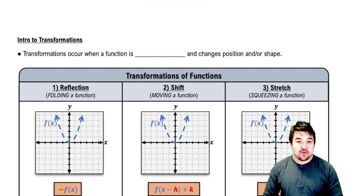Table of contents
- 0. Functions7h 52m
- Introduction to Functions16m
- Piecewise Functions10m
- Properties of Functions9m
- Common Functions1h 8m
- Transformations5m
- Combining Functions27m
- Exponent rules32m
- Exponential Functions28m
- Logarithmic Functions24m
- Properties of Logarithms34m
- Exponential & Logarithmic Equations35m
- Introduction to Trigonometric Functions38m
- Graphs of Trigonometric Functions44m
- Trigonometric Identities47m
- Inverse Trigonometric Functions48m
- 1. Limits and Continuity2h 2m
- 2. Intro to Derivatives1h 33m
- 3. Techniques of Differentiation3h 18m
- 4. Applications of Derivatives2h 38m
- 5. Graphical Applications of Derivatives6h 2m
- 6. Derivatives of Inverse, Exponential, & Logarithmic Functions2h 37m
- 7. Antiderivatives & Indefinite Integrals1h 26m
0. Functions
Transformations
Problem 11
Textbook Question
How do you obtain the graph of y=f(3x) from the graph of y=f(x)?
 Verified step by step guidance
Verified step by step guidance1
Start by understanding the transformation involved. The function y = f(3x) represents a horizontal compression of the graph of y = f(x).
Recall that multiplying the input of a function by a constant greater than 1 compresses the graph horizontally. In this case, the factor is 3.
To visualize this, consider any point (a, b) on the graph of y = f(x). For the graph of y = f(3x), this point will be transformed to (a/3, b).
This means that every x-coordinate on the graph of y = f(x) is divided by 3 to obtain the corresponding x-coordinate on the graph of y = f(3x).
Finally, sketch the new graph by applying this transformation to key points and features of the original graph, such as intercepts and turning points, to see the compressed version.
Recommended similar problem, with video answer:
 Verified Solution
Verified SolutionThis video solution was recommended by our tutors as helpful for the problem above
Video duration:
8mPlay a video:
Was this helpful?

 5:25m
5:25mWatch next
Master Intro to Transformations with a bite sized video explanation from Nick
Start learningRelated Videos
Related Practice


